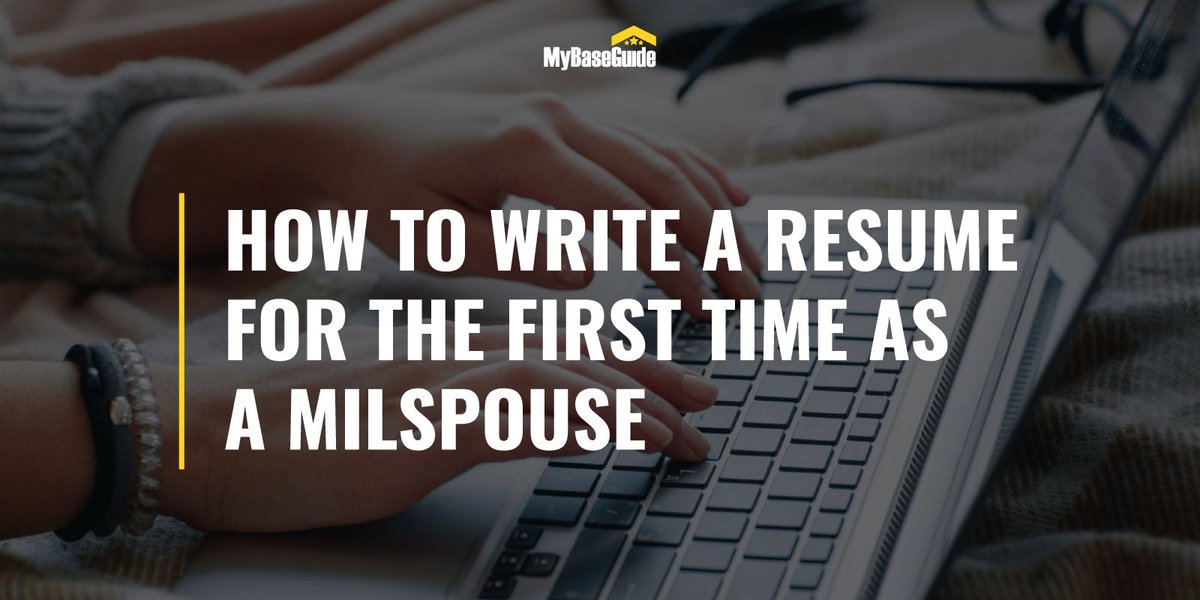HOW TO WRITE A RESUME FOR THE FIRST TIME AS A MILSPOUSE

Determine Your Resume Goal First
As resumes are still required for most job applications today, it’s important that you know what you want to accomplish with your resume. If you’re looking to break into volunteer work, that’s a totally different approach than if you’re seeking a high-level position with 20 years of experience behind you.
It’s time to learn how to write a bad*ss resume! The good news? You don’t need to learn how to become a resume writer in order to create an incredible resume that gets attention and interviews.
In general, the purpose of your resume should be to:
- Get a recruiter or hiring manager’s attention quickly (since they often only look at these for a few seconds before deciding if they want to dig into your application further).
- Showcase the most important achievements of your career.
- Tell a whole story of who you are and what you can bring to the table.
- Highlight keywords and skills that hiring managers are looking for in your field.
Many people spend plenty of time trying to create the perfect resume on their own. This can lead to a lot of frustration when someone else tells you it’s not good or after you’ve submitted it to dozens of places and had no response. Don’t make this mistake! When creating your resume for the first time, spend time and care putting it together. You will revise it over time, but it helps to have a really great base document.
Since you might have an older copy of your resume or one that belongs to a different industry, consider this a fresh start. If you’re a Veteran looking to work outside of IT or defense, you’ll especially need a reframe. The good news is that you probably have a lot of hands-on and soft skills developed from your military experience, but these need to be “recalibrated” for the civilian side.
Learn more about the job search – and what to avoid – here: 3 Things That Are Messing up Your Job Search & Tips to Help!
Review Your Past Experience
One of the best things you can do is evaluate all your past experience in a brain dump before trying to format it into a resume. Sitting down and looking at the formal outline of a resume can stress some people out and force them to want to get it perfect or to fit it into a certain format. Before getting to that point, brain dump everything you have learned, done, or achieved in past roles. That includes:- Volunteer positions
- Certifications achieved on the job or through your own efforts
- Education
- Special titles
- Achievements in certain positions
- Promotions
Once you’ve had some time to pull this all together, come back with a pen or a highlighter to emphasize the best bits from your brain dump. In your second pass, you’re looking for the information that is most relevant to the industry and positions you’re targeting now. What things can be reframed? Which experiences are no longer relevant? Which experiences pull on similar skills even if you’re aiming for a different role?
For military spouses, it’s common to have resume gaps. Don’t focus on this too much as you get comfortable learning how to write a resume for the first time. Focus on what you do have to offer. Telling a great overall story is important but can be challenging.
One thing that holds many spouses back when determining how to write a resume for the first time is that they don’t really want to (or maybe even can’t) tell how their career and skills have been impacted by their being a military spouse in a resume format. Instead, however, you can highlight how you have excellent generalized skills and so much to offer as an employee.
Most military spouses are driven, organized, and adaptable. Look for ways to turn what you might think of as a negative into positives. Where did you step into new volunteer roles or invest back in your education when it wasn’t possible to get a job due to a recent move? What have you learned about yourself in the military community and in living this lifestyle that makes you a diverse, valuable candidate? Military spouses often struggle with confidence in their careers, but they shouldn’t.
Just that as you learn more about how to write a resume for the first time, you’ll come back against that imposter syndrome or feeling of fraud. When it happens, let it roll off your back. It’s normal, but keep returning to the real evidence in front of you about everything you have to offer!
Determine What Pieces Belong on Your Resume
Especially if you’ve been in your field for a long time, it’s tempting to include all the details to show that you have an extensive background. However, you want to tailor your resume to your most important experiences.
If you have extensive experience in the military, include that as one job. It does not hurt to put your military service on your resume, especially since some employers might specifically want to hire from the military community. However, you should try to make your resume appeal to hiring managers in the civilian workplace.
If you’re struggling with space, aim for 1-2 pages max. Delete anything that is irrelevant or really old. If you’ve been in the workforce for 20+ years, look for ways to highlight your most pertinent and recent experience. Most employers do not care to go all the way back to college or high school unless you have a major achievement like a Fulbright Scholarship to highlight in relation to that time.
At this point, you should still only have a draft. Keep that handy since you’ll continue to refine it in future steps.
Make a goal of including at least four other relevant roles, even volunteer positions, on your resume. There are plenty of free online courses and tools you can use to brush up on skills or show how you’re seeking education in non-traditional ways, too.
Looking for volunteer opportunities to spruce up your resume? Check out our blog: How to Volunteer at a Military Base & Serve Our Country!

Look at Other Resumes in Your Field
The reason to do this after you’ve completed your own brain dump is that you don’t want to rely too much on what you “think” your resume should look like. This can hold you back by getting you distracted by style issues rather than substance. So start with the substance and then go back and put it into a format.When looking for format, make sure you use something that is:
- Clear and easy to read.
- Easily ported into PDF and Word formats without causing layout issues.
- Matches with the kind of style in your industry (for example, creative industries allow for more color and interesting layouts, whereas that would be distracting for an executive role).
- Flows nicely so that a person can quickly spot your education and skills.
- How they talk about teamwork.
- What industry buzzwords they use.
- Which tools/software are mentioned frequently.
- How they condense a lot of information or years into an easy-to-read format.
- Your objective (i.e., what kind of role are you looking for?) or overview (25-30 words about you and what you bring to a role).
- Your contact information.
- Your educational background.
- Your most recent or relevant roles.
- Any special skills, career highlights, or awards.
Final Proof With ATS Tools
Even if you’re not sure whether the company in question uses ATS, assume they do. You can use free tools to compare the job description of the position you’re applying to with your own resume. Yes, this means that you need to have a “base” resume, and then you might need to customize different versions of that for every new job you apply for.
Before you ask: Yes, this is annoying. However, going this extra step, at least for the jobs you’re really interested in, can make a big difference in your chances of being selected from the applicant pool.
You might save your initial document as FirstNameLastNameResume20XX and then have different versions for each company. I strongly recommend saving these and the cover letters you use in individual folders because some companies take months to get back to you.
Store your documents in a folder with a PDF or copy/pasted version of the job description (because they will probably pull the description off job sites and their website at some point, and you’ll completely forget what you applied for). Keeping it all together helps you match the job description to your materials and to have an informed call with someone from the company, even if they take three months to read and get your materials.
Trust me; this might not seem like a big deal with your first few submissions, but once you’re dozens deep into the process? You’ll be grateful you have a reference point.
You can use RezRunner or CVScan to help you compare your existing resume with the job description in play. Bear in mind that you don’t want it to seem robotic, so try to match at the 80% level. These tools will tell you other keywords to include to increase your chances of being picked up in the company’s software.

Keep a 1-Page and 2-Page Version & Update LinkedIn
If you have enough experience to warrant a two-page resume, that’s fine. Just bear in mind that some companies only want one page, so keep two versions with you so that you can quickly adapt and apply when you’re on the job hunt.
The one-page version should be limited to only your most relevant experience. It can be much harder to trim down your resume than it is to add things, so consider hiring a resume editor or career coach to help you with this process if you get stuck. Sometimes getting a fresh pair of eyes on your resume can make a world of difference!
Don’t forget that LinkedIn is like a living resume, too! These tips on how to write a resume for the first time correlate directly to your LinkedIn. So you can use these LinkedIn resume tips to add the same language to your profile.
After all, if it’s what’s being used in job descriptions and ATS, there’s a good chance it’s what’s being used on LinkedIn, as well. Make sure you have the best chance of standing out and being contacted by recruiters on this site by matching your new resume to your experience listed on that profile.
Find great jobs for milspouses here: 15 of the Top Work-From-Home Jobs for Veterans & Spouses
Laura Briggs
Laura Briggs is a Contributing Writer at VeteranLife.com.
Laura Briggs is a Contributing Writer at VeteranLife.com.
SHARE:



